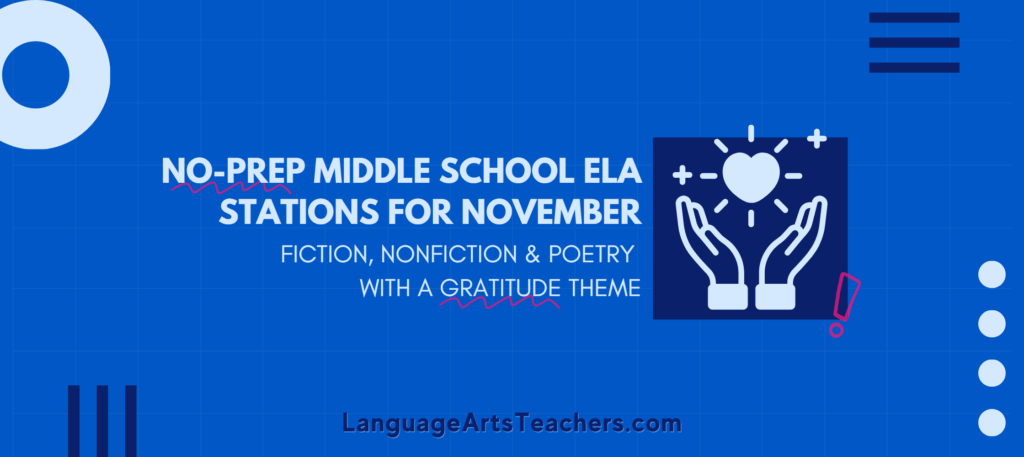Bell Ringers are Still Relevant
in a 6th Grade Language Arts Classroom!
Let’s Use Them to Their Full Potential!
Why I am such a huge fan of bellringers… You’ve gotta have a quick, easy way to start class each day.
…Something that’s not going to take up any time to create, something that will keep the students busy and engaged for a few minutes while you take care of housekeeping tasks (like taking attendance, taking a few deep breathes, stretching that tight calf muscle…).
Meanwhile, it shouldn’t be a wasted amount of time for your students. A bell ringer isn’t busy work. It should either be a quick review or reflection from something you taught yesterday, or it should provide for a nice “hook” or introduction to what you’re teaching today.
Or it should simply be interesting! Maybe it doesn’t tie directly to what you’re teaching… It could just be a logic puzzle or a riddle or something to spur some creative thinking.
For me, what works best is something that involves a little “quick write” that either reviews yesterday’s material or that hooks the students into what we’ll be learning today. At the same time, though, it has to be easy enough so that there aren’t a million questions about it (since I’m busy with attendance and stretching out that dang calf muscle).
I typically complete the necessary teacher stuff before time is up on the bell ringer activity, so that’s when I start moving around the room, checking on progress. Using a pen or pencil, I’ll leave little comments or smiley faces or something next to students’ bell ringer comments— just something small to show that I’m checking on them and that I’m reading them. Of course I don’t do this to all the students every day—that would be insane. But I can typically reach almost all the kids throughout the week as some point, and it drives the message home that I do notice what they’re doing and that what they’re doing is important.
Here are my hard-core rules about
bell ringers in my classroom:
-
A bell ringer should never take more than 5-10 minutes
-
Bell ringer time is quiet time (no questions or comments)
-
We always, always talk about the bell ringer when time is up
-
Even if a student has been absent for a week and has no idea how to respond to the bell ringer, at the minimum, he can copy it down and write an answer when we discuss it as a class in a few minutes
-
The discussion over it is very brief and is included in that 5-10 minutes I mentioned earlier
DO YOU GRADE THEM?
Yes, the bell ringers are a grade. Students turn in one sheet of paper each Friday right after that last bell ringer and they’re 20 points each (easy to grade since 5 x 20 = 100). Language Arts teachers like easy numbers 🙂 And really, I just glance over them super-quickly to see that all five have been answered. I don’t spend time reading them too closely.
HOW DO YOU GET THEM TO DO THIS EACH DAY?
So I “train” my students to come to class, sit down, and get the bell ringer done. If students are working on the bell ringer, then that means their pencils are sharpened, their papers are out, and they are seated. It means they’re at least sort of thinking about what they learned yesterday or what they’re about to learn today. It means they’re ready for class.
WHAT IF A KID IS ABSENT OR LATE?
If a student was absent the day before and missed the material the bell ringer is asking about, then they simply copy the bell ringer and then answer the prompt or the question as we discuss it. There’s never an excuse for not having the bell ringer done.
Sometimes students come in a few minutes late (like the school bus arrived late during 1st period, or the kid just got back from a dentist appointment, or another teacher held the student back for a few minutes to discuss something). So if a student is late, he or she simply records where they were in the place of that bell ringer’s topic and then that counts as a bell ringer grade (because bell ringers are also a way to practice time management, organization, etc.).
WHAT ABOUT KIDS WHO JUST DON’T GET IT TOGETHER IN THE FIRST FEW MINUTES?
Unfortunately, there are still a few students here and there who are simply never, ever ready for class… Maybe it’s because of goofing around, or because the same kid never seems to have a pencil. Whatever the case may be, the bell ringer grade each week provides very telling information when it comes time for parent meetings or for those lovely emails you get from time-to-time asking what Sarah can do to improve her grade.
“Um… Well… For starters, Sarah can come to class prepared. She never seems to be able to find her pencil and so she’s not getting her bell ringers done. We go over them each day in class and anyone who didn’t answer correctly or who got a little bit behind can still answer the question and still get full credit. It should be an easy 100 each week because of that. So for her to not be getting them done shows that she’s not ready to work each day and that’s putting her behind.”
So yeah, bell ringers can provide a lottttttt of information not only for how students are handling the material you’re teaching, but also for parents when they’re asking about student progress.
Types of Bell Ringers
One type of bell ringer is used to introduce a “new” concept (For instance, I know my students have learned about similes in years past, but they always need a little review before we really dive in each year).
The example below is taken from a three-week series of bell ringers I have that are used during my figurative language / poetry unit.
It quickly introduces the concept of the simile followed by three examples and a question. Students only have to write what the question tells them to write. I don’t make them copy all the information because of time, but you could if you wanted to. I can see how copying all the information and then answering the actual question could serve as a source of notes for the day that students could refer to later on in the unit.
Another type of bell ringer I use is like the one below where you can tell it’s designed to provide for a more writing-intensive activity much later in a unit.
In this particular case, I’m using it as a way to gauge my students’ understanding and analysis of a unit on text structures and text features. With one like this, give students a minute or two upon completion to share what they wrote with each other. You can move around the room listening to what they’re talking about to informally check their understanding. Any time we can provide writing and speaking opportunities about a topic is a good thing!
Another type of bell ringer is one that works at a much higher level. Check out the one below that appears late in my bell ringer series for teaching media messages / persuasive language.
SOME OF THESE SEEM HARD… HOW DO YOU DIFFERENTIATE?
For struggling students, they know that they can simply copy the definition that appears at the top of the slide and then fill in the rest as we discuss. For more advanced students, they can immediately begin the critical-thinking process the question requires.
Regardless of the “level” my many students are working at, I create bell ringers ahead of time for each unit that are designed to reach all students. Each one is modifiable simply by the instructions I give my students, and I don’t waste time creating two or three sets of bell ringers for each class. For my higher-level pre-AP classes, they jump immediately to the prompt or question. They know that expectation. I have one extremely low class in particular, but that class uses the exact same bell ringer, just in a different way— they start the bell ringer by copying the prompt or question and then together we discuss possible responses which they can then write about.
CLICK HERE FOR ACTIVITIES AND LESSONS YOU CAN START USING NOW >>






